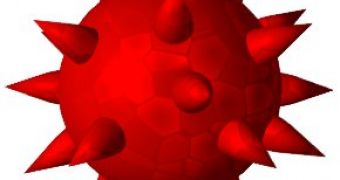HIV is a very tricky virus, and it's very good at playing hide and seek inside the body, but now, its latest hideout has been revealed and new drugs are on their way.
For the past three decades, scientists have been struggling to find a way of fighting this deadly virus, who has infected over 30 million people worldwide, but no approach was successful.
Who would’ve thought that HIV was hiding inside the immune system, adapting to living inside macrophage cells and thriving?
It is this ability to hide out in the body, which allows HIV to survive for decades and finally overcome the body's continuously immune assault.
The researchers discovered that the virus was hiding in macrophages, immune cells whose role is to chew and destroy foreign invaders and all cellular debris.
Baek Kim, PhD, professor of Microbiology and Immunology at the University of Rochester Medical Center, has been fascinated by the virus' ability to infiltrate immune cells for the past 15 years.
So for the past couple of years, he teamed with Emory scientist Raymond F. Schinazi, PhD, D.Sc., director of the Laboratory of Biochemical Pharmacology at Emory's Center for AIDS Research, to see whether the virus was able to avoid its normal way of replicating, when inside the macrophage.
The HIV needs a certain molecular machinery to replicate itself, a mechanism which is unavailable inside the macrophage, so, to overcome this and survive, the virus simply uses whatever molecule it finds.
The virus normally uses dNTP (deoxynucleoside triphosphate – the building blocks of the viral genetic machinery), but macrophages do not replicate, so dNTP is barely present here.
Instead, macrophages have high levels of a very closely related molecule, called rNTP (ribonucleoside triphosphate), which is more adaptable and can be used in cells in many ways.
The results of this research proved that HIV uses these last molecules instead of dNTP, to replicate inside macrophages.
Kim explained that “the virus would normally just use dNTP, but it's simply not available in great quantities in the macrophage.
“So HIV begins to use rNTP, which is quite similar from a chemical perspective.
“This is a surprise,” he said.
“The virus just wants to finish replicating, and it will utilize any resource it can to do so.”
So, when the team blocked the ability of the virus to interact with rNTP, its ability to replicate inside macrophages was reduced by 90%.
This is an amazing result, which brings hope of successfully fighting the virus and safe millions of lives.
Until now, drugs targeted dNTP instead of rNTP, to stop the infection in the CD4+ T immune cells, without any significant efficiency so far.
This new approach allows targeting the virus where it's most out of reach for current drugs, inside macrophages.
“The first cells that HIV infects in the genital tract are non-dividing target cell types such as macrophages and resting T cells,” Kim said.
“Current drugs were developed to be effective only when the infection has already moved beyond these cells.
“Perhaps we can use this information to help create a microbicide to stop the virus or limit its activity much earlier.”
Besides, it seems that a compound that targets rNTP already exists, and it is currently being tested for cancer.
Its name is Cordycepin, an experimental compound derived from wild mushrooms, and the team plans to test similar compounds as anti-HIV drugs.
Schinazi, who has developed several of the drugs currently used to treat HIV patients, said that “this significant breakthrough was unappreciated prior to our paper.
“We are now exploiting new anti-HIV drugs jointly based on this novel approach that are essentially not toxic and that can be used to treat and prevent HIV infections.”
The work was published in the Journal of Biological Chemistry.

 14 DAY TRIAL //
14 DAY TRIAL //